4.3E: Exercises
- Page ID
- 30121
\( \newcommand{\vecs}[1]{\overset { \scriptstyle \rightharpoonup} {\mathbf{#1}} } \)
\( \newcommand{\vecd}[1]{\overset{-\!-\!\rightharpoonup}{\vphantom{a}\smash {#1}}} \)
\( \newcommand{\dsum}{\displaystyle\sum\limits} \)
\( \newcommand{\dint}{\displaystyle\int\limits} \)
\( \newcommand{\dlim}{\displaystyle\lim\limits} \)
\( \newcommand{\id}{\mathrm{id}}\) \( \newcommand{\Span}{\mathrm{span}}\)
( \newcommand{\kernel}{\mathrm{null}\,}\) \( \newcommand{\range}{\mathrm{range}\,}\)
\( \newcommand{\RealPart}{\mathrm{Re}}\) \( \newcommand{\ImaginaryPart}{\mathrm{Im}}\)
\( \newcommand{\Argument}{\mathrm{Arg}}\) \( \newcommand{\norm}[1]{\| #1 \|}\)
\( \newcommand{\inner}[2]{\langle #1, #2 \rangle}\)
\( \newcommand{\Span}{\mathrm{span}}\)
\( \newcommand{\id}{\mathrm{id}}\)
\( \newcommand{\Span}{\mathrm{span}}\)
\( \newcommand{\kernel}{\mathrm{null}\,}\)
\( \newcommand{\range}{\mathrm{range}\,}\)
\( \newcommand{\RealPart}{\mathrm{Re}}\)
\( \newcommand{\ImaginaryPart}{\mathrm{Im}}\)
\( \newcommand{\Argument}{\mathrm{Arg}}\)
\( \newcommand{\norm}[1]{\| #1 \|}\)
\( \newcommand{\inner}[2]{\langle #1, #2 \rangle}\)
\( \newcommand{\Span}{\mathrm{span}}\) \( \newcommand{\AA}{\unicode[.8,0]{x212B}}\)
\( \newcommand{\vectorA}[1]{\vec{#1}} % arrow\)
\( \newcommand{\vectorAt}[1]{\vec{\text{#1}}} % arrow\)
\( \newcommand{\vectorB}[1]{\overset { \scriptstyle \rightharpoonup} {\mathbf{#1}} } \)
\( \newcommand{\vectorC}[1]{\textbf{#1}} \)
\( \newcommand{\vectorD}[1]{\overrightarrow{#1}} \)
\( \newcommand{\vectorDt}[1]{\overrightarrow{\text{#1}}} \)
\( \newcommand{\vectE}[1]{\overset{-\!-\!\rightharpoonup}{\vphantom{a}\smash{\mathbf {#1}}}} \)
\( \newcommand{\vecs}[1]{\overset { \scriptstyle \rightharpoonup} {\mathbf{#1}} } \)
\( \newcommand{\vecd}[1]{\overset{-\!-\!\rightharpoonup}{\vphantom{a}\smash {#1}}} \)
\(\newcommand{\avec}{\mathbf a}\) \(\newcommand{\bvec}{\mathbf b}\) \(\newcommand{\cvec}{\mathbf c}\) \(\newcommand{\dvec}{\mathbf d}\) \(\newcommand{\dtil}{\widetilde{\mathbf d}}\) \(\newcommand{\evec}{\mathbf e}\) \(\newcommand{\fvec}{\mathbf f}\) \(\newcommand{\nvec}{\mathbf n}\) \(\newcommand{\pvec}{\mathbf p}\) \(\newcommand{\qvec}{\mathbf q}\) \(\newcommand{\svec}{\mathbf s}\) \(\newcommand{\tvec}{\mathbf t}\) \(\newcommand{\uvec}{\mathbf u}\) \(\newcommand{\vvec}{\mathbf v}\) \(\newcommand{\wvec}{\mathbf w}\) \(\newcommand{\xvec}{\mathbf x}\) \(\newcommand{\yvec}{\mathbf y}\) \(\newcommand{\zvec}{\mathbf z}\) \(\newcommand{\rvec}{\mathbf r}\) \(\newcommand{\mvec}{\mathbf m}\) \(\newcommand{\zerovec}{\mathbf 0}\) \(\newcommand{\onevec}{\mathbf 1}\) \(\newcommand{\real}{\mathbb R}\) \(\newcommand{\twovec}[2]{\left[\begin{array}{r}#1 \\ #2 \end{array}\right]}\) \(\newcommand{\ctwovec}[2]{\left[\begin{array}{c}#1 \\ #2 \end{array}\right]}\) \(\newcommand{\threevec}[3]{\left[\begin{array}{r}#1 \\ #2 \\ #3 \end{array}\right]}\) \(\newcommand{\cthreevec}[3]{\left[\begin{array}{c}#1 \\ #2 \\ #3 \end{array}\right]}\) \(\newcommand{\fourvec}[4]{\left[\begin{array}{r}#1 \\ #2 \\ #3 \\ #4 \end{array}\right]}\) \(\newcommand{\cfourvec}[4]{\left[\begin{array}{c}#1 \\ #2 \\ #3 \\ #4 \end{array}\right]}\) \(\newcommand{\fivevec}[5]{\left[\begin{array}{r}#1 \\ #2 \\ #3 \\ #4 \\ #5 \\ \end{array}\right]}\) \(\newcommand{\cfivevec}[5]{\left[\begin{array}{c}#1 \\ #2 \\ #3 \\ #4 \\ #5 \\ \end{array}\right]}\) \(\newcommand{\mattwo}[4]{\left[\begin{array}{rr}#1 \amp #2 \\ #3 \amp #4 \\ \end{array}\right]}\) \(\newcommand{\laspan}[1]{\text{Span}\{#1\}}\) \(\newcommand{\bcal}{\cal B}\) \(\newcommand{\ccal}{\cal C}\) \(\newcommand{\scal}{\cal S}\) \(\newcommand{\wcal}{\cal W}\) \(\newcommand{\ecal}{\cal E}\) \(\newcommand{\coords}[2]{\left\{#1\right\}_{#2}}\) \(\newcommand{\gray}[1]{\color{gray}{#1}}\) \(\newcommand{\lgray}[1]{\color{lightgray}{#1}}\) \(\newcommand{\rank}{\operatorname{rank}}\) \(\newcommand{\row}{\text{Row}}\) \(\newcommand{\col}{\text{Col}}\) \(\renewcommand{\row}{\text{Row}}\) \(\newcommand{\nul}{\text{Nul}}\) \(\newcommand{\var}{\text{Var}}\) \(\newcommand{\corr}{\text{corr}}\) \(\newcommand{\len}[1]{\left|#1\right|}\) \(\newcommand{\bbar}{\overline{\bvec}}\) \(\newcommand{\bhat}{\widehat{\bvec}}\) \(\newcommand{\bperp}{\bvec^\perp}\) \(\newcommand{\xhat}{\widehat{\xvec}}\) \(\newcommand{\vhat}{\widehat{\vvec}}\) \(\newcommand{\uhat}{\widehat{\uvec}}\) \(\newcommand{\what}{\widehat{\wvec}}\) \(\newcommand{\Sighat}{\widehat{\Sigma}}\) \(\newcommand{\lt}{<}\) \(\newcommand{\gt}{>}\) \(\newcommand{\amp}{&}\) \(\definecolor{fillinmathshade}{gray}{0.9}\)Practice Makes Perfect
Identify the x- and y- Intercepts on a Graph
In the following exercises, find the x- and y- intercepts on each graph.

- Answer
-
(3,0),(0,3)
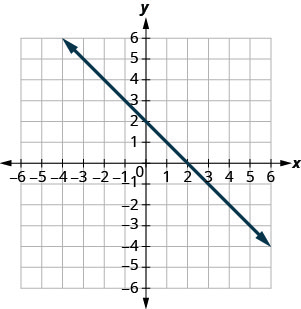
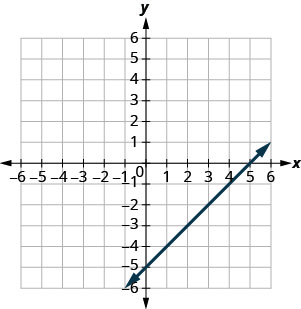
- Answer
-
(5,0),(0,−5)
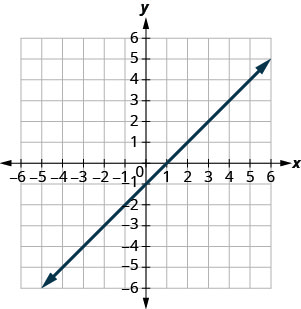
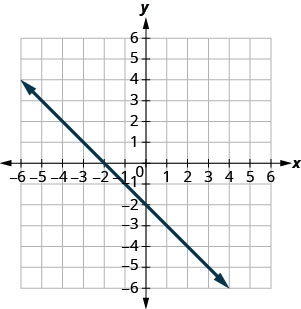
- Answer
-
(−2,0),(0,−2)
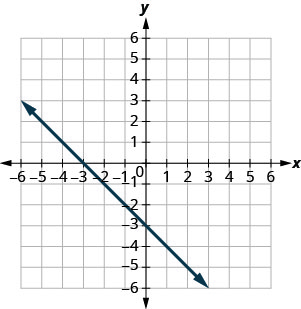
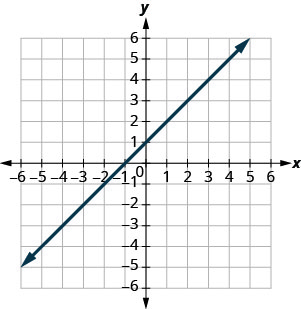
- Answer
-
(−1,0),(0,1)
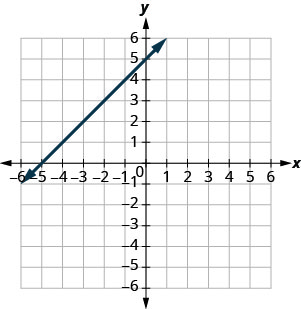
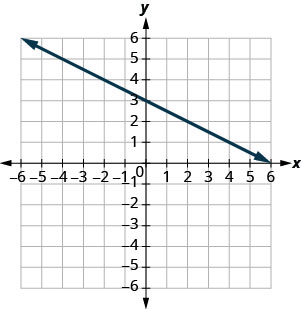
- Answer
-
(6,0),(0,3)
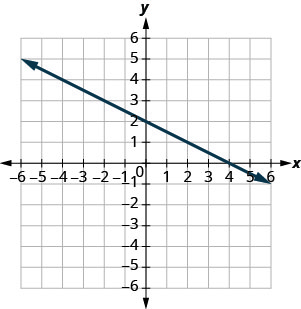
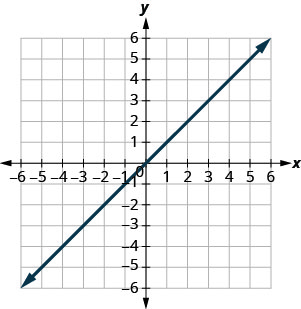
- Answer
-
(0,0)
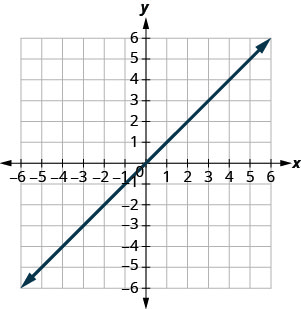
Find the x- and y- Intercepts from an Equation of a Line
In the following exercises, find the intercepts for each equation.
x+y=4
- Answer
-
(4,0),(0,4)
x+y=3
x+y=−2
- Answer
-
(−2,0),(0,−2)
x+y=−5
x–y=5
- Answer
-
(5,0),(0,−5)
x–y=1
x–y=−3
- Answer
-
(−3,0),(0,3)
x–y=−4
x+2y=8
- Answer
-
(8,0),(0,4)
x+2y=10
3x+y=6
- Answer
-
(2,0),(0,6)
3x+y=9
x–3y=12
- Answer
-
(12,0),(0,−4)
x–2y=8
4x–y=8
- Answer
-
(2,0),(0,−8)
5x–y=5
2x+5y=10
- Answer
-
(5,0),(0,2)
2x+3y=6
3x–2y=12
- Answer
-
(4,0),(0,−6)
3x–5y=30
\(y=\frac{1}{3} x+1\)
- Answer
-
(-3,0),(0,1)
\(y=\frac{1}{4} x-1\)
\(y=\frac{1}{5} x+2\)
- Answer
-
(−10,0),(0,2)
\(y=\frac{1}{3} x+4\)
y=3x
- Answer
-
(0,0)
y=-2x
y=-4x
- Answer
-
(0,0)
y=5x
Graph a Line Using the Intercepts
In the following exercises, graph using the intercepts.
\(-x+5 y=10\)
- Answer
-
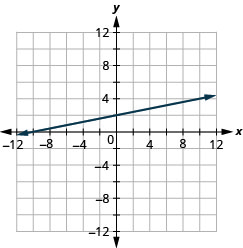
\(-x+4 y=8\)
\(x+2 y=4\)
- Answer
-
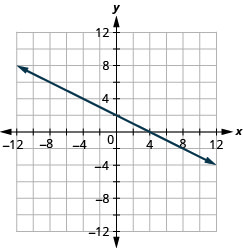
\(x+2 y=6\)
\(x+y=2\)
- Answer
-
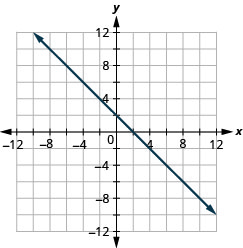
\(x+y=5\)
\(x+y=-3\)
- Answer
-
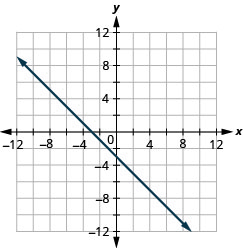
\(x+y=-1\)
\(x-y=1\)
- Answer
-

\(x-y=2\)
\(x-y=-4\)
- Answer
-
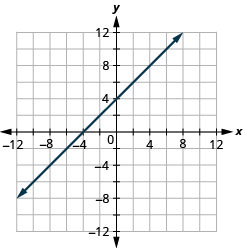
\(x-y=-3\)
\(4 x+y=4\)
- Answer
-
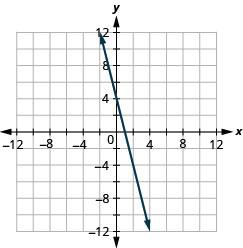
\(3 x+y=3\)
\(2 x+4 y=12\)
- Answer
-
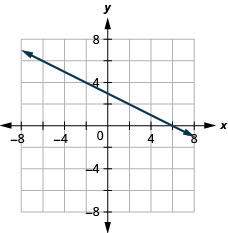
\(3 x+2 y=12\)
\(3 x-2 y=6\)
- Answer
-
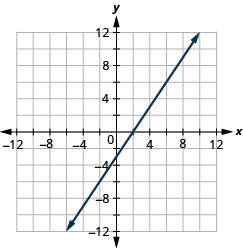
\(5 x-2 y=10\)
\(2 x-5 y=-20\)
- Answer
-
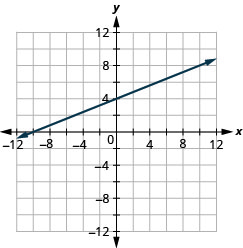
\(3 x-4 y=-12\)
\(3 x-y=-6\)
- Answer
-
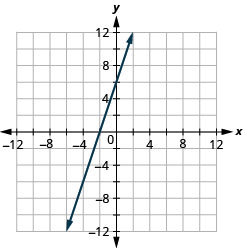
\(2 x-y=-8\)
\(y=-2 x\)
- Answer
-
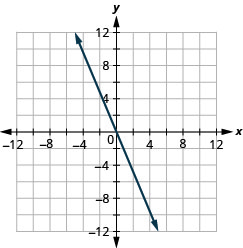
\(y=-4 x\)
\(y=x\)
- Answer
-
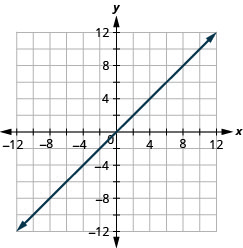
y=3x
Everyday Math
Road trip. Damien is driving from Chicago to Denver, a distance of 1000 miles. The x- axis on the graph below shows the time in hours since Damien left Chicago. The y- axis represents the distance he has left to drive.

- Find the x- and y- intercepts.
- Explain what the x- and y- intercepts mean for Damien.
- Answer
-
- (0,1000),(15,0)
- At (0,1000), he has been gone 0 hours and has 1000 miles left. At (15,0), he has been gone 15 hours and has 0 miles left to go.
Road trip. Ozzie filled up the gas tank of his truck and headed out on a road trip. The x- axis on the graph below shows the number of miles Ozzie drove since filling up. The y- axis represents the number of gallons of gas in the truck’s gas tank.

- Find the x- and y- intercepts.
- Explain what the x- and y- intercepts mean for Ozzie.
Writing Exercises
How do you find the \(x\) -intercept of the graph of \(3 x-2 y=6 ?\)
- Answer
-
Answers will vary.
Do you prefer to use the method of plotting points or the method using the intercepts to graph the equation 4x+y=−4? Why?
Do you prefer to use the method of plotting points or the method using the intercepts to graph the equation \(y=\frac{2}{3}x−2\)? Why?
- Answer
-
Answers will vary.
Do you prefer to use the method of plotting points or the method using the intercepts to graph the equation y=6? Why?
Self Check
ⓐ After completing the exercises, use this checklist to evaluate your mastery of the objectives of this section.

ⓑ What does this checklist tell you about your mastery of this section? What steps will you take to improve?


